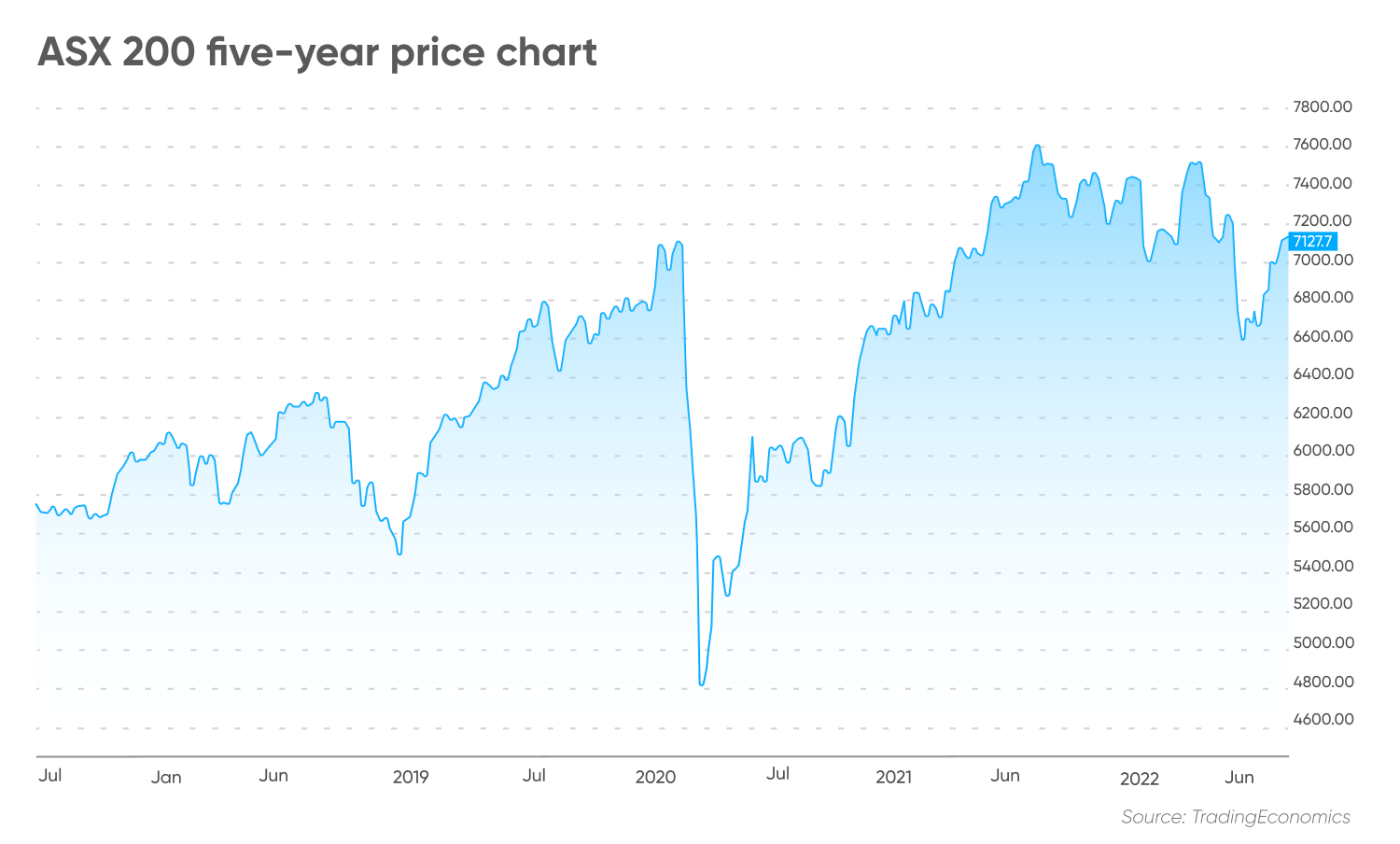ASX 200 forecast: Will Australian equities post gains in 2022?
What lies in store for the Australian index in 2022 and beyond.
Australia’s S&P/ASX 200 index (AU200) has rallied of late.
The benchmark index ended three straight months of losses to close about 6% higher in July. The rally helped the index close at its highest level in 10 weeks on 17 August 2022.
However, the recent bounce has not been enough to erase year-to-date (YTD) losses. As of 17 August, the ASX 200 index has lost over 6% YTD.
What does the future hold for the Australian equity market? Read on for information on the ASX 200 index, its historical price performance, analysts’ expectations and ASX 200 predictions from experts.
About ASX 200 index: Australian equity benchmark
The S&P/ASX 200 Index tracks the performance of the 200 largest companies listed on the Australian Securities Exchange (ASX).
According to index provider S&P Global, the S&P/ASX 200 has replaced the All Ordinaries Index as the key institutional benchmark index for the Australian market.
Companies are listed on the ASX 200 by their float-adjusted market capitalisation. This method measures the market capitalisation of shares readily available in the market and excludes those held by company insiders and promoters.
As of 29 July 2022, the financial sector dominated Australia’s benchmark index, accounting for about 29% of the index weightage. The Commonwealth Bank of Australia (CBA), the nation’s largest bank by market capitalisation, was the second largest constituent on the index.
The National Australia Bank (NAB), Westpac Banking (WBC), ANZ Banking Group (ANZ) and Macquarie Group (MQG) were other companies in the financial sector among the top 10 constituents on the ASX 200 index.
The materials sector held a 22.3% weight, with global miner BHP Group (BHP) the top constituent by index weight.
Other companies in the top 10 included healthcare company CSL, oil and gas producer Woodside Energy (WDS), retail conglomerate Wesfarmers (WES) and supermarket operator Woolworths (WOW).
The aggregate index weight of the top 10 constituents came in at about 47.5%, as of 29 July 2022.
Historical price performance: Post-pandemic rise to record highs

In 2020, the ASX 200 index fell to its lowest point since November 2012, hitting a low of 4,394.6 points on 22 March. However, the index bounced back strongly, recording monthly gains in 16 of the following 17 months.
By August 2021, the index had surged nearly 75% from its pandemic low, hitting an all-time high of 7,632 points.
In 2022, the ASX 200 has lost over 6% YTD, as of 17 August 2022. The start of quantitative tightening and fears of a slowdown in global economic growth has had a dampening effect in most equity markets.
The index posted three consecutive months of losses between April to June as the Reserve Bank of Australia (RBA) embarked on its first interest rate hike in 11 years.
Australian equity markets saw their worst monthly loss of the year in June 2022 as the ASX 200 slumped nearly 9%.
Since hitting a 19-month low of 6,407 points on 20 June, the index has rebounded over 11%, as of 17 August.
Price drivers: Factors influencing ASX 200 forecast
Inflation and interest rates
Rising inflation and interest rate hikes have been the story of the year so far in 2022. Multi-decade high inflation has forced central banks across the world to hike interest rates.
In August 2022, Australia’s RBA raised rates for the fourth consecutive month with a 50 basis points (bps) hike.
The hike cycle that started in May signalled the end of an era of ultra-low interest rates. The latest rate hike has lifted the nation’s cash rate rise from 0.1% in April to 1.85% in August.
Minutes from the RBA monetary policy board meeting on 2 August revealed the central bank will maintain its inflation-fighting stance for the rest of the year:
Analysts at Westpac IQ expected the RBA to hike rates by 50 bps again in September:
“Once having reached 2.35% in September it seems likely the Board will lower the pace to 25 basis points as policy moves into the ‘contractionary zone’. Note that unlike the Minutes to the July Board meeting there is no observation that ‘the level of interest rates was still very low’, suggesting that the Board is nearing that period of lower monthly increases.
“We also think that this sequence of 25 basis point movements will not incorporate a pause and will need to extend into 2023 with the final move in February.”
Sector performance
Australian real estate has been among the worst performing sectors in 2022. As of 17 August, sectoral index S&P/ASX Real Estate had lost over 17% YTD, compared to the ASX 200’s fall of about 6%.
Interest rate hikes have affected the property market in Australia as households see higher mortgage interest payments.
Felicity Emmett and Adelaide Timbrell, senior economist at ANZ Research, said in a note:
The duo added that they expected capital city house prices to fall as much as 18% over 2022 and 2023.
The real estate sector had the fourth largest sector weight in the ASX 200 at 6.7%, as of 29 July 2022.
The last month has seen risk appetite return to equity markets as investors bet on inflation and central bank hawkishness peaking.
The materials sector has led gains by returning over 13.5% in the last month, as of 17 August. The financial and real estate sectors have gained 7% and 5.5%, respectively, in the same period.
Over the last six months, Australia’s healthcare sector has returned over 7.5%, outperforming financials, materials and real estate. The healthcare sector held the third highest index weight on the ASX 200 at 10.4%, as of 29 July 2022.
Australia’s energy sector was the best performer, having returned about 23% YTD, as of 17 August.
Outlook: ASX 200 forecast for 2022 and beyond
As mentioned earlier, inflation and interest rate hikes look increasingly likely to dominate market proceedings in the remainder of 2022 and could affect any ASX 200 forecast.
On 2 August, Australia’s central bank raised its consumer price index (CPI) inflation for 2022 to around 7.75%, up from the 6% stated in May. The RBA also cut Australia’s gross domestic product (GDP) growth to 3.25% over 2022 from 4.25%, as previously stated.
“What this suggests for sharemarkets, and this bear market more specifically, is that we may not see the V-shaped recovery that we have almost come to expect in recent times, when markets have experienced a pullback.”
An ASX 200 forecast for 2022 from data provider Trading Economics expected the Australian benchmark index to fall to 6,867 points by the end of September quarter. It also forecast that the ASX 200 could trade at 6,396 points in August 2023. It did not provide an ASX 200 forecast for 2025 or ASX 200 forecast for 2030.
On 15 August, JP Morgan recommended an “underweight” rating for Australia in its equity strategy regional calls, noting that it was “cautious on Switzerland, HK and Australia”.
BlackRock advised caution in its weekly commentary published on 15 August 2022, noting:
Note that analysts’ ASX 200 forecasts can be wrong. Forecasts shouldn’t be used as a substitute for your own research.
Always conduct your own due diligence and remember that your decision to trade or invest should depend on your risk tolerance, expertise in the market, portfolio size and investment goals. Never invest more than you can afford to lose.
FAQs
Is ASX 200 a good investment?
The ASX 200 tracks the performance of the 200 largest companies listed on the Australian Securities Exchange (ASX).
Only you can decide whether it’s a suitable investment for your portfolio. Always conduct your own due diligence and remember that your decision to trade or invest should depend on your risk tolerance, expertise in the market, portfolio size and investment goals. Never invest more than you can afford to lose.
Will ASX 200 go up?
An ASX 200 forecast for 2022 from data provider Trading Economics expected the Australian benchmark index to fall to 6,867 points by the end of the September quarter.
Note that analyst ASX 200 forecasts can be wrong. Forecasts shouldn’t be used as a substitute for your own research.
Should I invest in ASX 200?
Whether ASX 200 is a good investment for you or not will depend on your portfolio composition, investment goals and risk profile, among other factors.
Always conduct your own due diligence and remember that your decision to trade or invest should depend on your risk tolerance, expertise in the market, portfolio size and investment goals. Never invest more than you can afford to lose.